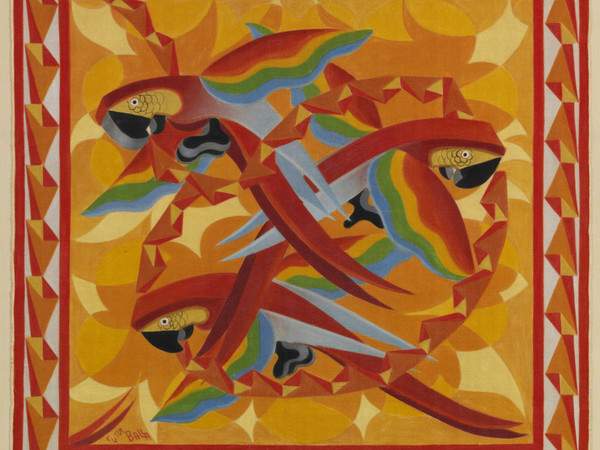Riva del Garda, MAG hosts lesser-known works of the 20th century from the Mart
MAG, Museo Alto Garda, has scheduled until October 29 the exhibition From Futurism to Informalism. Hidden Masterpieces in the Mart’s Collections. The result of a decade-long collaboration with the Mart Museum of Modern and Contemporary Art of Trent and Rovereto, the exhibition aims to show the general public a prestigious selection of masterpieces in the Mart’s collections belonging to some of the major artistic currents of the 20th century, such as Futurism, Post-World War II Realism,Abstractionism andInformalism.
The brainchild of Vittorio Sgarbi, president of MAG and Mart, and curated by Alessandra Tiddia, art historian and curator at Mart, the exhibition is conceived as a journey through twentieth-century Italian art. It is an exhibition itinerary that explores and narrates the conception and experimentation of new languages and expressiveness: the thirty-six masterpieces in the exhibition represent extraordinary testimonies of the most important artistic currents of the Italian twentieth century.
The initial section is a tribute to Futurism: in the first room, in fact, we find important works by famous artists belonging to this avant-garde, such as Rissa rustica (1936), Gallo (c. 1937-1938) and Il legnaiolo (19326-1931) by Fortunato Depero in dialogue with Pappagalli (1929) by Giacomo Balla and works by Gino Severini. This first part brings to mind the urgency of these artists in conceiving a different everyday aesthetic, rethinking lines, forms, and content so as to revolutionize the aesthetic ideal of the time and enact a Futurist reconstruction of the universe. Alongside these works are those of Tullio Crali and Mino Delle Site, futurist exponents of the so-called “Aeropittura” who intended to convey the sensations and emotions felt during flight so as to experience a dizzying vision of the landscape.
It continues with Massimo Campigli, Carlo Carrà, Felice Casorati, Giorgio de Chirico and Giorgio Morandi, artists who worked at the turn of the two world wars and distinguished themselves both by a need for the recovery of stable references, of safe havens to take refuge in the wake of the disasters caused by the conflicts, and by a reuse of the classical tradition thanks to a look towards the ancient. Emblematic in this sense are Carrà ’s works such as Natura morta con pesci (Still Life with Fish ) (1954) and Venezia e la Salute (The Customs House) (1938), which are characterized by simplified forms and synthetic figures, as well as Troubadour (1950), Piazza d ’ Italia-Pomeriggio d’Arianna (1972) and Figura di Giovane con oggetti metafisici (1969) by de Chirico that reinterpret classicism by contemplating ruin and giving it a metaphysical and enigmatic sense.
Campigli’sIdol (Caryatid) (1961) leads us back to a regal and majestic female body, with stylized and geometric features, as if suspended in a very distant time, whose eternity is cadenced by the rhythm of a few elementary forms.
Moving deeper into the exhibition we discover works by Renato Guttuso such as Woman at the Window (1942), Boogie-woogie (Boogie-woogie in Rome) (1953) and by Emilio Vedova such as Ciclo 62.B.B.9 (1962) and Uomo e macchina (1949): both artists, anti-fascists and members of the Italian Communist Party, experimented with new languages and expressiveness, one more popular, the other more gestural. The journey continues with exponents of Abstractionism such as Carlo Belli, Fausto Melotti and Mario Radice: Vaso (1955) by Melotti, a multifaceted artist, with its polychrome glazed ceramics, dialogues with the rosy tones of Radice’s and Belli’s works.
We then move on to the encounter with artistic exponents who have dedicated their productions to the reflection on the sign, the symbol, the referentiality of meanings and signifiers: these are Giuseppe Capogrossi, Gastone Novelli and Carla Accardi. By the latter, not only an artist but also an exponent of Italian neo-feminism, Lago artificiale n.2 (Artificial Lake in Sicily) (1962) and Integrazione (1957) are on display: in the former work there is a juxtaposition of color that causes a more intense light, while in the latter there is a vibration of small segments made in white on a black background that seem to represent an enigmatic handwriting, an unknown language.
Three extraordinary names close the exhibition: Alberto Burri, Antoni Tàpies and Lucio Fontana. Figure. Paisaje en gris (1956) by Tàpies, Sacco combustione (1952-1958) and Bianco Plastica BL1 (1964) by Burri delegate the intrinsic meaning of art to the material, encounter the unexplored and considered poor material compared to the traditional, such as sand, stones and shards used in their works, and experiment with a more instinctual gesturality.
Even more subversive appears to be the actions of Fontana, the founder of Spatialism, one of the neo-avant-gardes of the second half of the 20th century. Through holes and cuts, concentrated and thoughtful, his works seem to transcend boundaries and project into infinity.
These are some of the protagonists of this exhibition itinerary that aims to attract both the Italian and foreign tourist public visiting Lake Garda in the summer period, as well as the enthusiasts and connoisseurs of the subject who have the opportunity to admire in the Museum of Riva del Garda the important masterpieces of the Mart, the result of a targeted acquisition strategy, which go to make up one of the most extensive and significant collections of modern and contemporary art in all of Europe.
For all information, you can visit the MAG’s official website.
Pictured: Giacomo Balla, Pappagalli (1929), oil on tapestry canvas, 125 x 125 cm, Mart, Museum of Modern and Contemporary Art of Trento and Rovereto Long-term Deposit
 |
| Riva del Garda, MAG hosts lesser-known works of the 20th century from the Mart |
Warning: the translation into English of the original Italian article was created using automatic tools. We undertake to review all articles, but we do not guarantee the total absence of inaccuracies in the translation due to the program. You can find the original by clicking on the ITA button. If you find any mistake,please contact us.



























